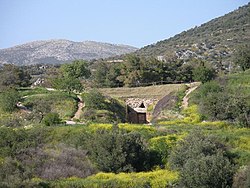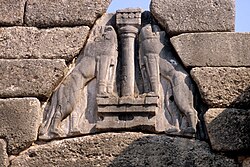Mycenae
Mycenae (Greek Μυκῆναι Mykēnai or Μυκήνη Mykēnē), is an archaeological site in Greece. It is about 90 km south-west of Athens, in the north-eastern Peloponnese.
| Μυκῆναι Μυκήνη | |
| Location | Argolis, Greece |
|---|---|
| Coordinates | Coordinates: 37°43′51″N 22°45′23″E / 37.730792°N 22.756382°E |
| Type | Settlement |
| History | |
| Periods | Bronze Age |
| Cultures | Ancient Greece |
| Official name | Archaeological Sites of Mycenae and Tiryns |
| Type | Cultural |
| Criteria | i, ii, iii, iv, vi |
| Designated | 1999 (23rd session) |
| Reference no. | 941 |
| State Party | Greece |
| Region | Europe and North America |
In the second millennium BC, Mycenae was one of the most important centers of early Greek civilization with a strong army. The time of Greek history from about 1600 BC to about 1100 BC is called Mycenaean Greece.
People
The Mycenaeans of Greece had learned many things from other lands. By 1400 B.C., they were known for their art, literature, and philosophy.[1] Their most important city, Mycenae (mi see' née), was just north of what later became Corinth.
In 1300 BC the king built a wall 23 ft wide and 60 ft high.[1] The stone blocks used were very big. A corbel arch, where each stone hung a little further beyond the one below, was used. A triangle was also used to support it. The Lion Gate, the main gate of the wall and an example of a corbel arch, is still admired today.[1]
The common people went inside the palace walls in times of danger but at other times lived in their own houses.[1] Their houses were shaped like deep rectangles with flat roofs and front porches.[1] People worked at many different jobs. They were cooks, doctors, carpenters, tailors, woodcutters, and makers of textiles. The Mycenaeans grew many things and kept animals like oxen, sheep, pigs, and goats. They also built good roads and bridges. Their army was strong. Spears and javelins have been found, and also many swords, big and small.[2][3] Their edge and point were used.[4]
Decline and collapse
By 1200 BC the power of Mycenae was declining. The eventual destruction of Mycenae was part of the general Bronze Age collapse in the Greek mainland and beyond. Within a short period all the palaces of southern Greece were burnt, including that at Mycenae. The cause or causes of the Bronze Age collapse are not known for sure.
Religion
For their worship of gods, these people made shrines.[1] Poseidon was worshiped as a chief deity, and the “protector of the sky” was Zeus. They also worshipped Apollo, Artemis, Hera and many others of the Greek religion.[1]
Mycenae Media
References
- ↑ 1.0 1.1 1.2 1.3 1.4 1.5 1.6 Hofflund, M.A., Ethel. History and geography 603 The civilizations of Greece and Rome. Rock Rapids: Alpha Omega Publications, Inc.
- ↑ "Mycenaean swords". Archived from the original on 2014-10-03. Retrieved 2010-03-12.
- ↑ Mycenaean Type G sword (Horn Sword)
- ↑ "Mycenaean dagger". Archived from the original on 2010-02-20. Retrieved 2010-03-12.
Other websites
| Wikimedia Commons has media related to Lua error in Module:Commons_link at line 62: attempt to index field 'wikibase' (a nil value).. |
- British School at Athens Mycenae page Archived 2006-09-25 at the Wayback Machine
- Excavation of Citadel House Area
- Objects from Grave Circle A, including votive weaponry
- Homepage of Current Dickinson College Excavations at Mycenae Archived 2011-07-27 at the Wayback Machine
![]()










